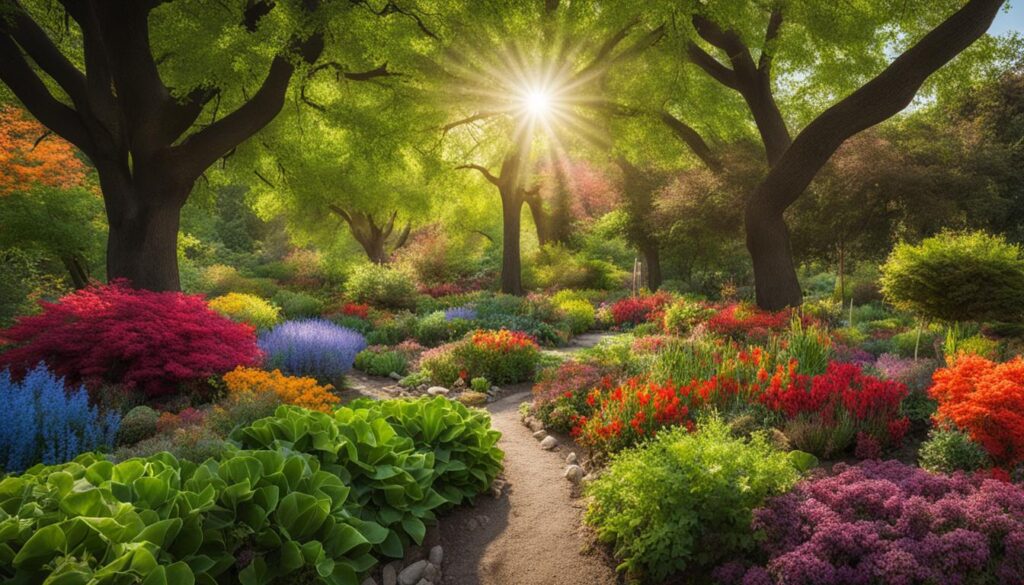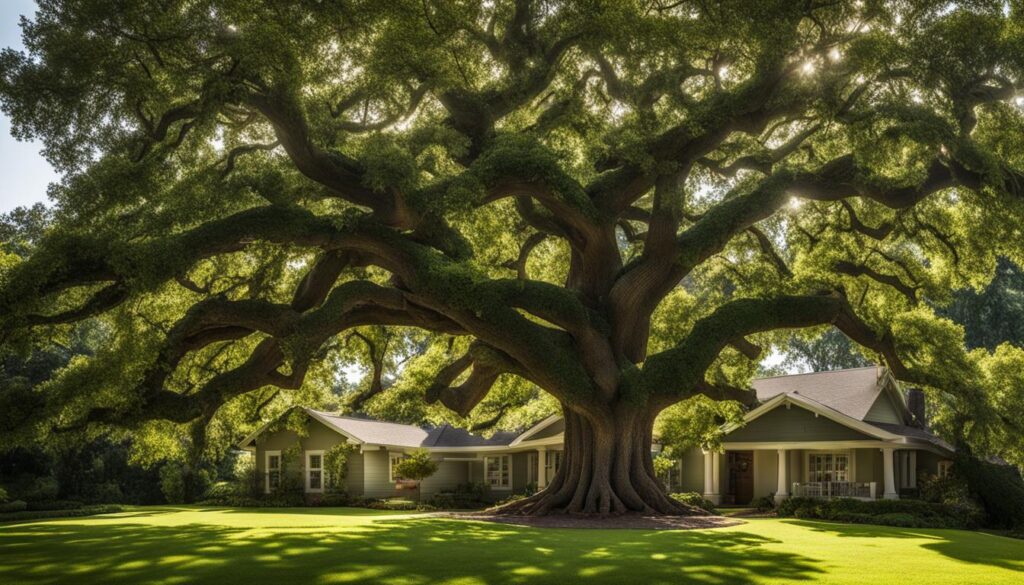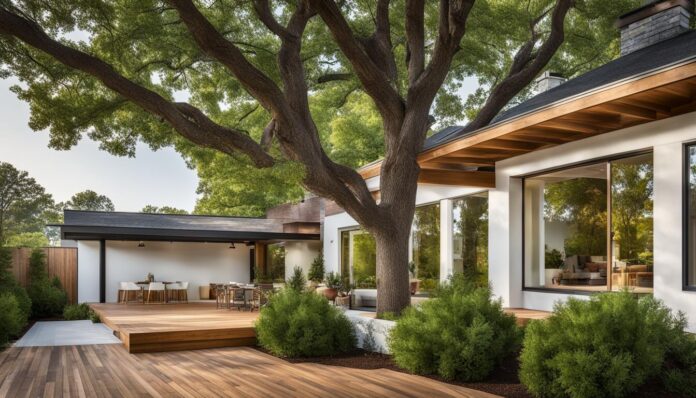Planting trees in your yard not only adds visual interest and curb appeal but can also increase your property value by 3 to 15 percent, according to Arborist News. Additionally, trees can help reduce energy costs by providing shade and acting as windbreaks. Choosing the right trees for your home involves considering your climate zone, desired attributes (such as shade or color), soil conditions, and future growth potential.
Key Takeaways:
- Planting trees can increase your property value by 3 to 15 percent.
- Trees can help reduce energy costs by providing shade and acting as windbreaks.
- Consider your climate zone, desired attributes, soil conditions, and future growth potential when choosing trees for your home.
How Trees Add Value to Your Home
Did you know that planting trees in your yard can do more than just enhance the aesthetics? It can significantly increase your home value while also reducing your heating and cooling costs. Studies have shown that homes with trees can have up to 15% higher value compared to those without. Mature trees have even been appraised at values ranging from $1,000 to $10,000-plus, according to the Council of Tree and Landscape Appraisers.
But how exactly do trees contribute to the increase in property value? Let’s take a closer look.
The Value-Adding Benefits of Trees
- Increasing Property Value: Trees enhance the overall appeal of your property, making it more desirable to potential buyers. A well-maintained landscape with beautiful trees can create a lasting impression and help fetch a higher price for your home.
- Reducing Energy Costs: Trees provide natural shade, shielding your home from the scorching heat during summer months. This shade helps to cool your house, reducing the need for excessive air conditioning and ultimately lowering your cooling costs. Additionally, trees act as natural windbreaks during winter, minimizing heat loss and cutting down on heating expenses.
To better understand the impact trees can have on your energy costs, consider this: on average, shade from just one healthy tree can lead to an energy savings of around $50 annually. Now imagine the potential savings with multiple trees strategically placed around your property.
“A mature tree can often exceed the value of the landscaped property as a whole, according to many professionals in the field of resale and landscaping.”
So, not only can trees enhance the beauty and value of your home, but they also provide long-term economic benefits by reducing your utility bills.
| Benefits | Impact on Home Value |
|---|---|
| Increased curb appeal | An attractive landscape can increase property value by up to 5%. |
| Energy efficiency | Trees can help reduce cooling costs by up to 50% and heating costs in winter. |
| Noise reduction | Strategically planted trees can act as barriers, reducing noise pollution and increasing property value. |
| Improved air quality | Trees absorb pollutants, improving the air quality in your neighborhood and potentially raising property values. |
By investing in trees and maintaining a well-designed landscape, you not only create an inviting environment but also increase the worth of your home while saving on your energy expenses.
Factors to Consider When Choosing Trees
When selecting trees for your home, it’s essential to consider several factors to ensure you make the right choice. Here are key considerations to keep in mind:
- Pick the Right Tree: Assess your specific needs and preferences to find a tree that matches your requirements. Consider attributes such as shade, fast growth, fall foliage colors, or ornamental blooms.
- Compatible with Your Cold-Hardiness Zone: Determine the cold-hardiness zone of your area to select trees that can withstand the local climate.
- Soil Conditions: Take into account the soil conditions in your yard, including its pH level and drainage capabilities. Different tree species thrive in various soil types.
- Full Sunlight or Shade: Understand the sunlight requirements of the tree you’re considering. Some trees prefer full sunlight, while others thrive in partial shade.
- Adequate Spacing: Consider the available space in your yard and ensure the tree you choose has enough room to grow both above and below ground.
- Plant Diversity: Maintain a balance of different tree species to promote biodiversity and create a more resilient ecosystem.
- Native Plants: Native trees are often a top choice as they are adapted to the local environment, requiring less maintenance and offering better chances of successful growth.
By considering these factors, you can select the perfect trees for your home that will thrive in your specific conditions and add long-term value to your property.

Trees That Increase Property Values: Oaks
Oaks are highly prized for their attractive large canopies, rounded spreads, and gorgeous fall foliage colors. Varieties such as red oak, white oak, and pin oak are popular choices for home landscapes. They can grow to heights of 40 to 80 feet, have a spread of 40 to 100 feet, and thrive in full sun or partial shade. These long-lived trees add beauty and value to any property.
If you’re looking to enhance your home’s curb appeal and increase its value, consider planting oak trees in your yard. With their impressive size and magnificent fall foliage, oaks are sure to catch the eye of potential buyers.
One of the main benefits of oak trees is their longevity. Oaks are known to be long-lived, with some species living for hundreds of years. This means that by planting an oak tree now, you’re investing in a long-term asset that will continue to beautify your property and add value for generations to come.
Another reason why oaks are highly sought after is their large canopies. These trees provide ample shade, making them perfect for creating a cool and comfortable outdoor space. Whether you’re looking to relax in the shade or enjoy a picnic with family and friends, an oak tree can provide the perfect setting.
Furthermore, oaks are famous for their stunning fall foliage colors. From vibrant reds to rich oranges and golden yellows, the leaves of oak trees light up the landscape during the autumn season. With their striking colors, oaks bring a touch of beauty and warmth to any property.
Adding oaks to your home landscape is not only a visually appealing choice but also a smart investment. These long-lived trees with their attractive large canopies and captivating fall foliage colors will undoubtedly increase the value of your property.
To give you an idea of the visual impact of oak trees, take a look at this captivating image:

The image showcases an attractive large-canopied oak tree, adorned with vibrant fall foliage colors. This is just a glimpse of the beauty and value that oak trees can bring to your home.
Trees That Increase Property Values: Maple and Willow
When it comes to choosing trees that can enhance both the aesthetic appeal and value of your home, two standout options are the red maple and weeping willow. These trees offer unique features that can transform your landscape and make your home more attractive to potential buyers.
The red maple, with its stunning red fall foliage, is a top choice for homeowners looking to add a touch of color to their surroundings. Not only does it provide a burst of vibrant red hues during the autumn months, but it also produces winged seeds that add visual interest to your yard throughout the year. The red maple is a versatile tree that can reach heights of 40 to 60 feet, making it a striking focal point in any landscape. It thrives in full sun and complements a variety of architectural styles.
On the other hand, if you’re seeking a tree that exudes elegance and grace, the weeping willow is an excellent option. With its cascading branches and pendulous, sweeping foliage, this tree creates a serene and soothing atmosphere in any outdoor space. Weeping willows can grow up to 60 to 80 feet tall, providing ample shade and a natural focal point for your landscape. They thrive in full sun or partial shade, making them adaptable to different environmental conditions.
Maple and Willow Comparison
| Tree | Main Features | Height | Preferred Lighting |
|---|---|---|---|
| Red Maple | Red fall foliage, winged seeds | 40-60 feet | Full sun |
| Weeping Willow | Graceful, cascading branches | 60-80 feet | Full sun or partial shade |
Both the red maple and weeping willow possess qualities that can enhance the overall value and appeal of your home. Whether you’re seeking a tree with vivid fall colors or one that imparts a sense of tranquility and beauty, these options are sure to leave a lasting impression. Consider incorporating red maple and weeping willow trees into your landscape to create a captivating and inviting outdoor environment for your home.
Trees That Increase Property Values: Flowering Trees
When it comes to enhancing the beauty and value of your home, flowering trees are a top choice for homeowners. With their fragrant blooms and visual appeal, trees like magnolias and cherry trees instantly add charm to any landscape.
Magnolias, known for their iconic, large, and showy flowers, can reach impressive heights of 60 to 80 feet. These majestic trees thrive in full sun to partial shade, making them adaptable to various growing conditions. Their stunning blooms bring a touch of elegance and sophistication to any property.
Cherry trees, on the other hand, are beloved for their beautiful spring blossoms. These trees can grow anywhere from 50 to 80 feet tall, creating a striking focal point in your yard. Whether you choose the delicate pink flowers of the Yoshino cherry tree or the vibrant red blooms of the Kwanzan cherry tree, you can be sure that these trees will make a lasting impression.
Additionally, consider adding fruit trees to your landscape. Fruit trees, such as plum or apple trees, not only provide visual interest but can also yield delicious rewards for homeowners. Imagine picking fresh fruit from your very own backyard! Not only will these trees enhance the aesthetics of your property, but they can also be a source of joy and satisfaction.
FAQ
How do trees add value to a home?
Trees add value to a home by increasing its property value by 3 to 15 percent, according to Arborist News. They also help reduce energy costs by providing shade and acting as windbreaks, cutting down on cooling and heating expenses.
What factors should I consider when choosing trees for my home?
When selecting trees for your home, it’s important to consider your climate zone, the desired attributes of the tree (such as shade or fast growth), the soil conditions in your yard, the amount of sunlight the tree requires, the need for adequate spacing, and the importance of plant diversity. Native plants are often a good choice as they tend to grow well and require less care.
What are some trees that increase property values?
Oaks are highly prized for their large canopies, rounded spreads, and gorgeous fall foliage colors. Red oak, white oak, and pin oak are popular choices for home landscapes. Red maple trees are favored for their red fall foliage and winged seeds, while weeping willows are known for their graceful, cascading branches. Flowering trees like magnolias and cherry trees with fragrant blooms also add value to a home. Fruit trees like plum and apple trees can provide visual interest and tasty rewards for homeowners.

